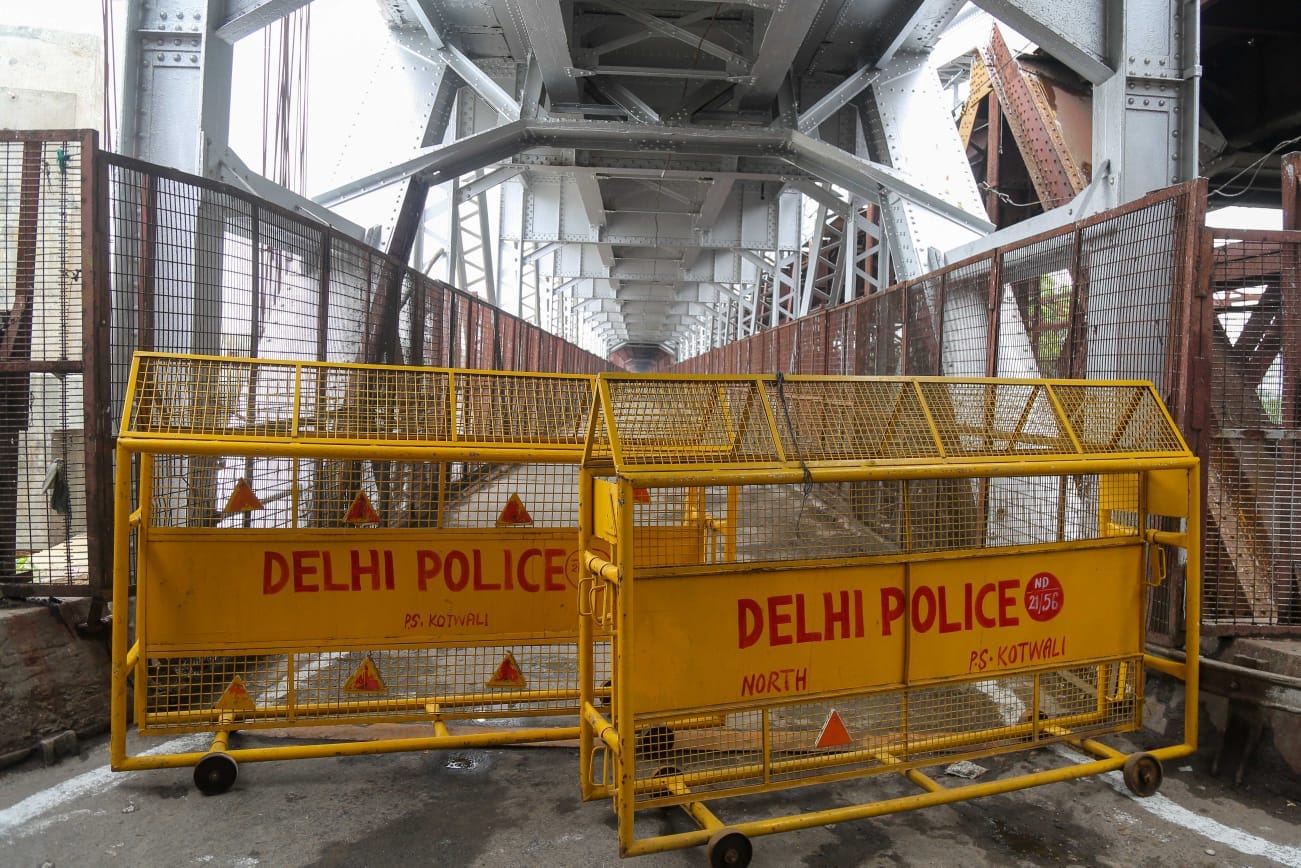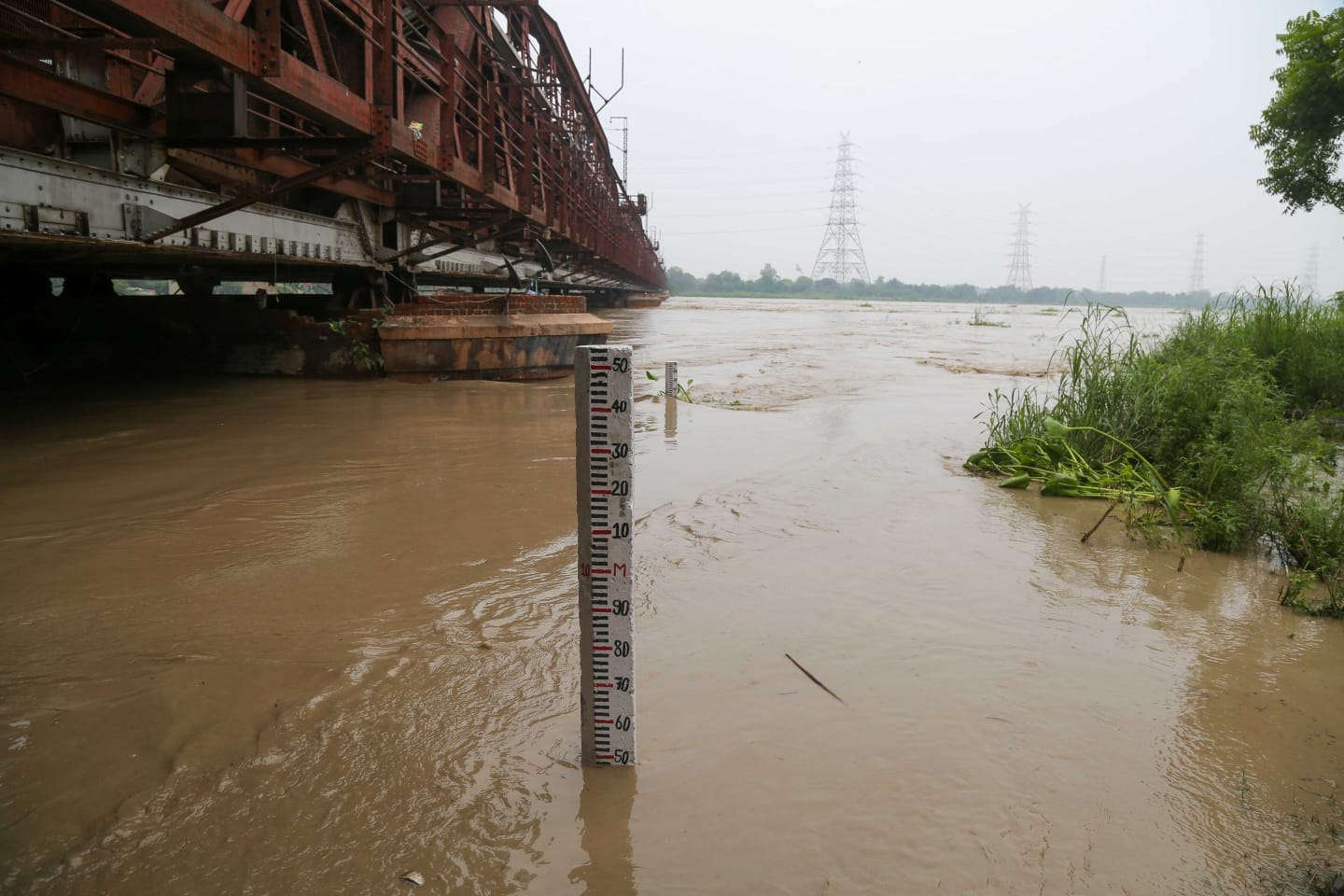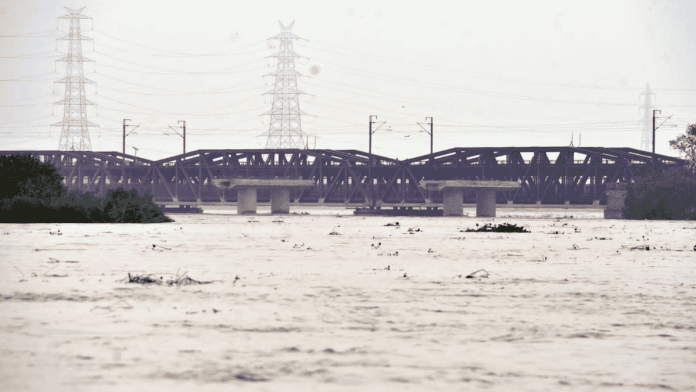New Delhi: Over the mighty Yamuna and connecting Delhi’s old quarters to its Shahdara district and the outskirts of the national capital beyond that is a 160-year-old iron truss bridge that now stands submerged in floodwaters. It’s been three days since the Yamuna, in all her fury, rose dangerously, washing into many parts of Delhi, including areas such as posh Civil Lines.
The Old Yamuna Bridge, known locally as lohe ka pul (iron bridge) or Bridge Number 249 in railway parlance, is waiting for the floodwater to recede.
Built by the East Indian Railway Company as part of a railroad link between Delhi and the then capital Calcutta in 1863, the Old Yamuna Bridge was regarded as an architectural marvel. The 2,640 feet bridge consists of 12 spans, all measuring 202.5 feet each, and is the first bridge of its kind in north India, according to Indian Railways officials, who also claim it to be one of the oldest standing bridges in the country.
This isn’t the first time that the bridge has found itself submerged under Yamuna’s waters, however, according to Chaube Singh, a 67-year-old man from Bihar, who says he has been guarding the bridge for the better part of the decade. The Victorian-era bridge, which stands as a connection between India’s past and its present, withstood five floods — 1956, 1967, 1971, 1975, 1978, says Singh, the bridge guard on contractual employment with the railways.
Once the only link between Delhi and Calcutta, the double-decked bridge with a walkway at the bottom continues to serve to this day, seeing an average railway traffic of 90 trains each day, according to railway officials.
Standing in the backyard of the Red Fort, it has witnessed several critical chapters of India’s modern history, such as the British rule, India’s independence movement, the birth of a new country, and, eventually, the last major flood in Delhi in 1978, when Yamuna’s waters rose to 207.49 metres.
Construction of the bridge was overseen by George Sibley, chief engineer of the northwest province of the East Indian Railway Company who is also credited with the Naini Bridge in Prayagraj (formerly Allahabad) and the old Delhi railway station, George Huddlestone, former superintendent of East India Railway, writes in his book History of the East Indian Railway. The book was published in 1902.
It wasn’t only the railways that found the bridge useful — the walkway under the bridge could be used to cross the river. Before its construction, travellers would have to use a pontoon bridge — specialised shallow draft boats or floats tied together to help cross a river or canal. This proved particularly tricky to use in the monsoon, when the Yamuna waters rose.
“Until the 1860s, when the bridge came up, there was only a bridge of boats across the Yamuna, and that too was seasonal, because it used to be dismantled in the monsoon, or it would have been washed away,” Swapna Liddle, a historian who specialises in Delhi’s history, told ThePrint.
She added: “During monsoon, one could only cross the river by ferry. Even after the first railway line to Delhi was constructed in 1864, people had to disembark at Shahdara and travel over the bridge of boats to come into the city.”

According to Huddlestone, Albert Edward, then Prince of Wales and the eldest son of Queen Victoria, travelled to Delhi using the bridge on his visit to India in October 1875.
Mention the bridge and those living in the vicinity open a bag of memories and anecdotes — not all of them about the bridge, but connected to it somehow. Like the story of the watermelons, which is repeated by many old timers from the area.
“The Yamuna is a shallow river. There would be farmers living around the bridge, who would cultivate melons on the sandbars of the river,” said Delhi historian Sohail Hashmi.
This was before slums came up in the area and the river’s water got increasing polluted, he added.
“At the peak of summer, we would take boats and go buy fresh watermelon, muskmelon and pumpkin from those farmers. It was a tradition. The entire neighbourhood would go,” Hashmi recalled.
Over time, the old Yamuna bridge became a favourite spot for coin divers, who jump into the river to retrieve the modest offerings that a generation of the devout made to the river.
Also Read: In the same boat, yet not — surviving the Delhi floods, a tale of two localities
A link to the past
According to Huddlestone, the first train between Howrah and Delhi using the Old Yamuna Bridge some time in 1864.
“The line between Calcutta and Delhi not only possessed political advantages of the highest order but would also prove a success as a commercial speculation,” Huddlestone says in his book, calling the bridge the “last of the great bridges” .
Once built, it got the attention of the British press. Among those to rave about it was Rudyard Kipling, a Bombay-born British journalist, better known as the writer of the renowned The Jungle Book and Kim.
According to Huddlestone, Kipling, in his short story The Bridge-Builders — published in the Christmas issue of Illustrated London News in 1893 — claimed that the railway bridges in India illustrated how the Europeans imposed “technological diffusion” on colonised societies.
But according to Hashmi, there was a more pressing motive for the link — after the “rebellion” of 1857, now recognised as the first war of Indian independence, the British decided to move their capital to Calcutta and, as a punitive measure for Delhi’s role in the revolt, wanted to cut it off from its planned railway network for India.

But when traders in Delhi and Punjab appealed against it, the British gave in, seeing it as an opportunity for moving troops to curb any further rebellion. Out of spite, however, they aligned the Yamuna bridge in such a way that part of the Red Fort wall — the symbol of the 1857 rebellion — had to be broken.
“It was done to punish Delhi for the rebellion,” Hashmi told ThePrint. “Many petitioned but the British were resolute. And that’s how the old iron bridge came into existence,” Hashmi said.
A bridge still standing
In 2018, the Northern Division of Indian Railways renovated the Old Yamuna Bridge, replacing 700 tonnes of iron. This, according to railway officials ThePrint spoke to, was done because of “severe corrosion” that aged the bridge by 50 years.
Since 2003, the Indian Railways has also been constructing a parallel bridge over the river, but that work is still ongoing, with authorities now reportedly giving a deadline of September this year.
According to A.K. Jain, former commissioner (planning) of the Delhi Development Authority, while the old bridge has undergone several minor to moderate repairs, no extensive renovation has been carried out yet.
“The lifespan of an iron bridge is only 100 years. But this bridge has outlived that and has crossed 150 years,” Jain said, adding that iron for the bridge had been brought from the United Kingdom in the 19th century.
In a 2018 Public Accounts Committee report on bridge maintenance, the Indian Railways pointed out that while “certain railway bridges constructed during the British rule are in a good condition, railway bridges constructed or reconstructed after independence are of inferior quality and need frequent repair”.
For Vivek Shukla, a retired journalist, the bridge represents his own childhood and youth. He particularly recalls the floods of 1978, when he went there with his friends.
“The bridge had then also been a place of respite for locals, where they can go and watch the river,” he said.
But the bridge also has other uses. In an article publisehd in The Hindu on 19 June, 2016, late historian R.V. Smith, a Delhi chronicler, talks about a father and son who worked as bridge guards in the 1950s. In addition to their guard duties, the duo had another job — they would diligently record the water level in the Yamuna, particularly during winter and monsoon.
It’s a practice that’s followed till today — sitting on his rickety wooden chair, bridge guard Chaube Singh has been monitoring water levels in the river and regularly reporting to local authorities.
“Once upon a time, the bridge was submerged in the Yamuna. There was a severe flood. Everyone thought that the bridge would be destroyed. But as the water receded, the bridge was standing resolute,” he tells ThePrint, hitting his bamboo stick on the ground.
It’s a thought that Sahil Arora, a 40-year-old travel agent who came to Delhi’s ITO last week to see the Yamuna flood water echoes.
“People died but the bridge didn’t. Nothing will happen to the bridge. It was made by the Britishers,” Arora told ThePrint.
(Edited by Uttara Ramaswamy)






